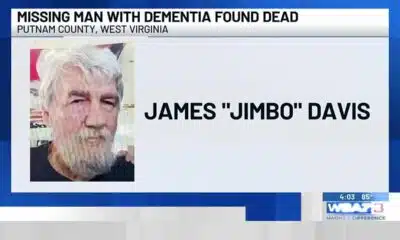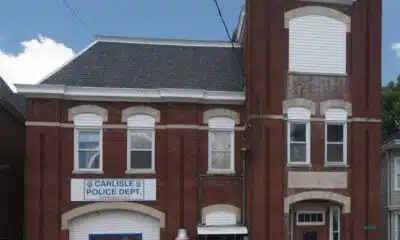News from the South - Missouri News Feed
Johnson County DA says officer’s use of deadly force against suspect was ‘justified’
SUMMARY: Johnson County District Attorney Steve Howe will not charge a Shawnee police officer who shot at Issac Ortiz, 19, after Ortiz fired a gun in a public intersection on June 17. Ortiz, with a history of mental illness, had stolen a truck and handgun the night before. Officer B pursued Ortiz after spotting him acting suspiciously, leading to a chase and a shootout in a wooded area; no one was injured. Ortiz was arrested and charged with attempted capital murder and interference with law enforcement. The DA ruled the officer’s use of deadly force was justified for self-defense, supported by evidence including camera footage and shell casings. Ortiz’s next hearing is September 26.
Read the full article
The post Johnson County DA says officer's use of deadly force against suspect was 'justified' appeared first on fox4kc.com
News from the South - Missouri News Feed
Disaster destroyed their St. Louis homes. Then the real estate ‘vultures’ swooped in
by Sophie Hurwitz, Missouri Independent
September 3, 2025
When a mile-wide tornado hit St. Louis on May 16, DeAmon White hopped in his car and rushed home. As he navigated downed trees and power lines, turning his 10-minute commute into a three-hour slog, he worried whether his family, neighbors, and home made it through unscathed.
When he turned the corner onto his block, White’s heart sank. The entire back wall of his house had been blown off. Chunks of ceiling plaster littered the floor, windows were shattered, and much of his property was damaged beyond repair.
Next, White checked on his mother, Bobbie, who lives a five-minute walk away. The third floor of her home was gone. But miraculously, her front yard flower garden made it through the 150 mph winds unscathed.
The St. Louis storm, an EF-3, was just one of 60 tornadoes that tore through Missouri, Illinois, Kentucky, Wisconsin, Minnesota, and the Carolinas over 48 hours in May, killing at least 26 people and injuring 168.
DeAmon and Bobbie considered themselves lucky: A neighbor of theirs had his leg impaled by a pole that flew through his window. Bobbie went to her sister’s house to get some sleep; DeAmon spent the night in his truck, trading shifts with neighbors to fend off looters.
The next morning, at 8 a.m., the phone calls started: Would he be interested in selling his home? “They were aggressively going at it,” he said. This continued for the next two weeks, with half a dozen calls every single day.
They’re “vultures,” Bobbie and DeAmon both called the speculators. Some walked down the street with flyers, some texted, and some called.
In White’s West End neighborhood, an estimated 63 percent of renters and 49 percent of homeowners are uninsured. For many North St. Louis residents, their homes are their only major asset, meaning they don’t have the cash on hand necessary to rebuild without insurance. And when federal aid is slow to arrive, quick offers to buy a home in cash can look like a lifeline.
“Hi, this is Paul with H.B. LLC,” read one text sent to a homeowner just north of the tornado’s path on August 4. “Touching base with you … is this Steven?”
Grist tried contacting several of these numbers, but most were not set up to receive call- or text-backs. One, however, did pick up. A woman, sounding like she was in a call center, asked if there was a property to sell. “We’re a ‘we buy homes’ company,” she said, but repeatedly refused to give Grist the company name.
Eight months earlier and 600 miles away, Gina Miceli’s community in Fairview, North Carolina, was devastated by Hurricane Helene, which triggered hundreds of landslides. The rushing earth swallowed up homes and cars and killed 15 of her neighbors. In the months following, she received near-constant texts asking if she’d be open to selling her family’s two plots of land.
“They text really chummy, so they sound like they already know you,” Miceli said. “‘Hey, Gina, it’s so-and-so!’ It’s very, very creepy.”
“Let me know your price,” said one text on July 9, signed simply, “Bella.”
“Hi there Gina, hope you’re having a great day,” said another exactly two weeks later. “My name is Christine, I am a land buyer. I’m reaching out to see if you have any plans to sell the lot.” The text was signed by “Twin Acres.” Twin Acres is not a registered real estate broker. Grist’s attempt to text the number back went unanswered.
Sometimes, Miceli said, she answers the texts. “It depends on my mood. I think there’s been a time or two I’ve said, ‘Go to hell.’” She has no plans to leave. She’s raising her family in the home her husband’s grandparents bought, and she owns a local brewery.
Some theorists call this phenomenon “disaster gentrification,” when real estate investors flood a disaster zone to buy up damaged properties for cheap.
Samantha Montano, a professor of emergency management and author of the book Disasterology, spent years living and working in New Orleans after Hurricane Katrina and saw it happen with her own eyes. In areas like the Lower Ninth Ward, some people displaced by the storm didn’t have the resources to return. Speculators rushed in. Some landowners became instant millionaires, selling their properties to out-of-state developers hoping to rebuild and flip their property.
“The issue of gentrification in New Orleans was there from the beginning,” Montano said. “There were many groups who were warning about that, advocating for housing policy and other recovery policies to account for gentrification. [They] tried to prevent it.”
Twenty years later, the demographics of New Orleans have shifted: Lower-income and Black residents have been displaced, and whiter, wealthier new residents took their place. “Certainly that is all very much intertwined in the recovery and in who had access to the resources to return and rebuild — and who didn’t,” she said.
In the wake of the Eaton Fire in Altadena, California, earlier this year, half of home purchases were by limited liability corporations, according to Dwell, the home design news site. That’s nearly double what they typically represent compared to individuals buying homes.
Just six companies — among them Ocean Development Inc. and Black Lion Properties LLC — dominated those transactions in Altadena, spending millions of dollars to purchase destroyed properties in historically Black neighborhoods. It’s difficult to find out who these companies are: Often, they contact potential sellers through fake phone numbers or under names that aren’t necessarily attached to real corporations.
The value of disaster-struck land consistently bounces back fast, meaning that buyers can flip the land or homes — sometimes even without making repairs. As climate change fuels more frequent severe natural disasters across the United States, “disaster investors” seem set to make greater profits than ever — and communities like North St. Louis stand to bear the burden.
Justin Stoler, a University of Miami researcher working on urban health disparities, recently published a paper on hazard gentrification. This phenomenon, Stoler told Grist, diverges from our standard understanding of gentrification in its speed. “It’s typically happening in a very punctuated, short-term manner. It doesn’t necessarily take years and decades to roll out.”
“People’s lives are completely upended, and they’ve got to make difficult choices,” Stoler said. “And opportunistic entities, companies, investors try to step in and get a good deal. You end up with this system where people are exploiting the misfortunes of others.”
In DeAmon White’s neighborhood, he saw the signs of gentrification long before the tornado: A community barbershop replaced by a trendy new restaurant; a former school turned into an upscale apartment building inhabited by law students; and “just a lot of white folks moving into what they used to call ‘the hood,’ you know?”
And investors were already circling. Signs with “WE BUY UGLY HOUSES” could be found on utility poles and in mailboxes before the May storm. These are markers of real estate wholesalers and house-flippers looking for a quick sale. But they increased in frequency and aggressiveness after the neighborhood was turned to rubble, he said.
It’s a little too soon to say whether the St. Louis tornado will lead to big land buys. But signs — and Zillow search results — are pointing in that direction.
At least 10 severely damaged homes in the tornado’s path have gone up for sale on the real estate platform Zillow in recent weeks. Each one is labeled not as a home for locals to move into, but as an investment opportunity: 4641 Maffit Avenue “offers investment potential” for rehab or brick salvage, with a starting bid of $20,000; 4236 East Sacramento Avenue — “Investor Special!! Tornado damaged property” — in the historic Ville neighborhood is going for $30,000.
A hundred days after the storm, many St. Louis neighborhoods remain as damaged as they were the day of the tornado in May. Debris still litters streets and yards, blue tarps still stand in for caved-in roofs, and windows are still boarded up — even as the weather cools. Community activist organizations are providing aid where they can. One group, The People’s Response, which mobilized some 10,000 volunteers, estimates that over 2,000 St. Louis households still require housing and shelter assistance.
But even with a robust volunteer network, $30 million from an NFL settlement redirected toward tornado relief, and FEMA aid (slowly) arriving, homeowners have been left in the lurch for months, facing a difficult decision about how — or even whether — to rebuild.
Deserai Anderson Crow, who researches community resilience at the University of Colorado-Boulder, says what is happening in St. Louis follows a pattern similar to other extreme weather disasters: Those who rebuild are more often than not landlords looking for renters, rather than people who intend to live in the homes they’re rebuilding.
“It’s a predatory renting cycle,” Crow said. “These huge industrial-rental landlords are trying to snap up disaster-affected homes because they assume, correctly, that a lot of people want to get out from under those mortgages as quickly as possible, and that they just don’t have the emotional bandwidth or financial bandwidth to deal with rebuilding.”
Bobbie White’s damaged home was built in 1901, back when St. Louis was a thriving Mississippi River transit hub. One of the industries that built St. Louis was brickmaking, with the materials renowned worldwide for their strength and quality. Bobbie’s home, and others on her block, are made of those bricks. “A lot of these houses are 100-year-old structures,” DeAmon said. What is built in their stead likely won’t be as unique or sturdy, and yet will cost far more, he lamented — prices out of reach for many in the neighborhood today.
Stacey Sanders, president of the St. Louis Association of Realtors, says she’s been inundated with reports of speedy post-disaster sale offers. But they often come with red flags: For one thing, multigenerational homes may not have access to a title, or the title might be in the name of a deceased family member. Sometimes, resolving title issues can take years.
Many of the storm-impacted multigenerational homes are in that legal category. Those “heirs’ property” homeowners are stuck, Sanders said. Without a title, it can be harder to access FEMA benefits, filing an insurance claim is extremely difficult, and sales without a title are legally dubious at best.
When Sanders’ own home and car were hit by a tornado this March, “we had letters, door hangers, people knocking on the door, doing everything.” They were either selling her on repairs or selling her on a home purchase. She was, as a professional real estate agent, able to access resources and recover her damaged property. But she worries others may have a harder time.
“It might be the easiest and the quickest way,” Sanders said, “ but it’s not always the best way to go. A lot of the people that are out making these offers on houses are not doing it because they’re like, ‘Oh, these poor people, let’s give them a fair shake.’”
Instead, they’re seeing “desperate people” and chasing an opportunity to buy property for far less than it is worth.
GET THE MORNING HEADLINES.
There are options to curb this mass sell-off. One tactic, Crow, of the University of Colorado, said, is providing a few months of bridge funding so residents can stay and navigate the rebuilding process.
Another is to stymie buyers: This June, the Ohio Senate passed a bill requiring real estate wholesalers to tell homeowners when they may be selling their homes for less than market value. Pennsylvania passed a similar law in January.
The market in Missouri, however, remains unregulated at both the local and state level, according to attorney Peter Hoffman of Legal Services of Eastern Missouri, a nonprofit that has been providing pro bono services to tornado victims.
“They find people in vulnerable situations that maybe don’t have equal access to information,” Hoffman said. Those issues — redlining, displacement, exploitation — existed before the tornado. But the storm, he said, brought them to the light.
Talking on the phone between orders of fish, fried okra, and potato salad while at his restaurant, Ozell’s Kitchen and Food Mart, DeAmon White reflected on the last few months.
Rebuilding his home has been hard. Though he does have insurance, he expects his home won’t be livable until February or March, the better part of a year after the tornado. Because he’s disabled, with a partially amputated foot, he stays mostly on the first floor of his mother’s house. A neighbor of his is still living in a camper on her lot. Others, he said, took the offer to sell.
Right now, there are only four families left on his block. On Aug. 21, White said, his mother received an offer in the mail: A man named Chris wanted to buy her home for about two-thirds of what it was worth.
“I really would like the people who are in the line of gentrification to realize what it is they have, and if they can, don’t sell out,” White said. “I know money talks, and when you’re in a stressful situation you got to do what you got to do, but resist, you know?”
This article originally appeared in Grist, a nonprofit, independent media organization dedicated to telling stories of climate solutions and a just future. Learn more at Grist.org
Missouri Independent is part of States Newsroom, a nonprofit news network supported by grants and a coalition of donors as a 501c(3) public charity. Missouri Independent maintains editorial independence. Contact Editor Jason Hancock for questions: info@missouriindependent.com.
The post Disaster destroyed their St. Louis homes. Then the real estate ‘vultures’ swooped in appeared first on missouriindependent.com
Note: The following A.I. based commentary is not part of the original article, reproduced above, but is offered in the hopes that it will promote greater media literacy and critical thinking, by making any potential bias more visible to the reader –Staff Editor.
Political Bias Rating: Center-Left
This content highlights issues of social and economic justice, focusing on the exploitation of vulnerable communities in the aftermath of natural disasters. It critiques real estate speculation and disaster gentrification, emphasizing the struggles of lower-income and historically marginalized residents. The article advocates for regulatory measures and community support, reflecting a perspective that leans toward progressive policies and social equity, typical of center-left viewpoints. However, it maintains a factual tone without overt partisan rhetoric, keeping it from being far-left.
News from the South - Missouri News Feed
Third set of twins for St. Louis area mom: 8 kids total
SUMMARY: Solita Drone from Wentzville, Missouri, recently gave birth to her third set of twins, totaling eight children—four boys and four girls. Twins run in her family, with her brother and relatives also having multiple sets. Doctors say having three sets of twins is extremely rare, about one in three million pregnancies. Her household includes two single children and twins born in 2013, 2015, and 2025. Despite challenges like complicated pregnancies and managing a busy household, Drone treasures her children as blessings. She emphasizes breaking generational curses and plans to cherish her youngest twins, her final set.
The post Third set of twins for St. Louis area mom: 8 kids total appeared first on fox2now.com
News from the South - Missouri News Feed
Missouri governor sued for activating National Guard ahead of ‘No Kings’ protests
by Jason Hancock, Missouri Independent
September 2, 2025
The son of a Republican lawmaker is suing Missouri Gov. Mike Kehoe alleging his First Amendment rights were violated when Kehoe preemptively declared a state of emergency and activated the National Guard in anticipation of what turned out to be peaceful protests against the Trump administration across the state and nation in June.
Lucas Cierpiot, a disability-rights activist from Blue Springs, said he felt intimidated by the governor’s actions and too unsafe to attend any “No Kings” protests on June 14. His lawsuit alleges the order violated Cierpiot’s right to free speech, free assembly and association.
It also was an act of discrimination based on disability, Cierpiot contends, since those with vision impairments would be uniquely vulnerable “to projectile weapons fired by crowd control troops.” Ciepriot is legally blind in one eye.
“It was an abuse of process to declare a false emergency when a true emergency did not exist,” Cierpoit writes in his lawsuit. “When Kehoe issued the order, there were no protests occurring anywhere in Missouri at all, and certainly not any that were un-peaceful.”
A spokeswoman for Kehoe declined comment on the pending lawsuit, instead pointing to the governor’s June 12 statement when he declared the state of emergency.
“We respect, and will defend, the right to peacefully protest,” Kehoe said at the time, “but we will not tolerate violence or lawlessness in our state.”
Two days before scheduled protests in June, Kehoe signed Executive Order 25-25, activating the Missouri National Guard as a “precautionary measure” to protect against “events that are occurring or could occur.”
The move was denounced by the ACLU of Missouri as an “unnecessary provocation to thwart public dissent” and by House Minority Leader Ashley Aune as “a blatant attempt to intimidate and suppress First Amendment rights.”
A day after issuing the order, Kehoe announced that he would be leaving the country during the state of emergency for a long-planned trade mission to Europe.
Anti-Trump ‘No Kings’ rallies draw thousands to peaceful protests across Missouri
Thousands gathered that Saturday at protests in cities and towns across the state, as well as around the steps of the Missouri Capitol in Jefferson City. The weekend protests were peaceful and came and went without incident.
Protesters demonstrated throughout the U.S. that day as President Donald Trump hosted a military parade in Washington on his birthday. The coordinated events followed Trump’s deployment of the National Guard to Los Angeles against the wishes of California Gov. Gavin Newsom. Demonstrators spoke against Trump’s immigration crackdowns and dismissals of federal workers.
Cierpiot was not among the protesters.
He writes that he originally planned to attend, given his history of advocating for “civil, constitutional and anti-discrimination rights of persons with blindness, low-vision and/or diseases of the eye.”
But Cierpiot said the governor’s order and the activation of the National Guard prevented him from participating in the protests.
“Kehoe issuing this escalatory false emergency declaration represented a very real threat to plaintiff’s safety,” the lawsuit says, adding that Cierpiot was not afraid of anything related to the protests themselves and only felt unsafe due to the “possibility of police or military response.”
Rubber bullets, pepper spray and tear gas, Cierpiot says in the suit, “are a significant threat to a patriot with low-vision and/or diseases of the eye,” threatening the “permanent loss of what remaining vision plaintiff does have as a price of exercising free speech.”
Cierpiot — whose father is state Sen. Mike Cierpiot, a Lee’s Summit Republican — is currently representing himself in the lawsuit, which was filed in Jackson County. He said in an email to The Independent that he is in the process of interviewing attorneys.
Last year, Cierpiot garnered headlines after filing a formal complaint accusing Missouri Attorney General Andrew Bailey of violating the rules of professional conduct for lawyers. The complaint focused on campaign contributions and accused Bailey of using his office “for his personal political benefit.”
The Office of the Chief Disciplinary Counsel declined to investigate the complaint, leading Cierpiot to request the Missouri Supreme Court intervene. The court declined to get involved and the ethics complaint was dismissed.
Help Local Journalism
As a nonprofit newsroom, our articles are free for everyone to access. Readers like you make that possible. Can you help sustain our watchdog reporting today?
Missouri Independent is part of States Newsroom, a nonprofit news network supported by grants and a coalition of donors as a 501c(3) public charity. Missouri Independent maintains editorial independence. Contact Editor Jason Hancock for questions: info@missouriindependent.com.
The post Missouri governor sued for activating National Guard ahead of ‘No Kings’ protests appeared first on missouriindependent.com
Note: The following A.I. based commentary is not part of the original article, reproduced above, but is offered in the hopes that it will promote greater media literacy and critical thinking, by making any potential bias more visible to the reader –Staff Editor.
Political Bias Rating: Center-Left
The article primarily focuses on a criticism of a Republican governor’s actions in response to peaceful protests, highlighting concerns about civil liberties such as the First Amendment and disability rights. It references opposition from civil rights groups like the ACLU and includes detailed perspectives from a plaintiff opposing the governor’s measures, which frames the story with a critical viewpoint towards government overreach and actions perceived to suppress dissent. While it presents some statements from the governor’s office, the overall tone and emphasis lean toward advocating for protest rights and scrutinizing conservative authority, characteristic of a Center-Left bias.
-
Mississippi Today4 days ago
DEI, campus culture wars spark early battle between likely GOP rivals for governor in Mississippi
-
News from the South - Louisiana News Feed7 days ago
K+20: Katrina alters local health care landscape, though underlying ills still the same
-
News from the South - North Carolina News Feed6 days ago
Parasocial party: Why people are excited for the Taylor Swift, Travis Kelce engagement
-
Local News6 days ago
Police say Minneapolis church shooter was filled with hatred and admired mass killers
-
Local News Video5 days ago
08/29 Ryan's “Wet End to the Week” Friday Forecast
-
News from the South - Kentucky News Feed6 days ago
Lexington Man Convicted of Firearms Offenses
-
News from the South - Arkansas News Feed7 days ago
Catholic community in Fayetteville prays for Minneapolis victims, reflects on safety
-
News from the South - Arkansas News Feed6 days ago
Sylvan Hills defeats Maumelle in Zero Week thriller












































